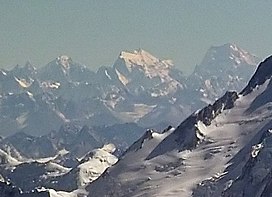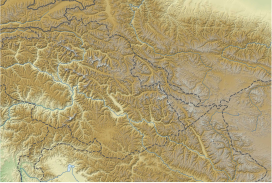Saltoro Kangri
| Saltoro Kangri | |
|---|---|
 Saltoro Kangri, at right | |
| Highest point | |
| Elevation | 7,742 m (25,400 ft)Ranked 31st |
| Prominence | 2,160 m (7,090 ft) |
| Listing | Ultra |
| Coordinates | 35°23′57.6″N76°50′55.2″E/ 35.399333°N 76.848667°E |
| Dimensions | |
| Length | 80 km (50 mi) |
| Geography | |
Saltoro Ridge,Siachen,Actual Ground Position Line,Saltoro Kangri on the border between Indian and Pakistani controlled territories | |
| Parent range | Saltoro Mountains,Karakoram |
| Climbing | |
| First ascent | 24 July 1962 by Y. Takamura, A. Saito, Capt. Bashir[1] |
| Easiest route | rock/snow/ice climb |
 | |
| Saltoro Kangri | |||
|---|---|---|---|
| Traditional Chinese | Tát nhĩ thác lạc cương nhật phong | ||
| |||
Saltoro Kangri,previously known asPeak 36,stands as the highest peak within theSaltoro Mountainssubrange, which is part of the largerKarakoramrange. This subrange is also referred to as the Saltoro Range and is situated within the Karakoram region. The term "Saltoro Kangri" typically encompasses both of its twin peaks, Saltoro Kangri I (located to the south) and Saltoro Kangri II, which are connected by asaddle.When comparing heights, the generic term "Saltoro Kangri" is used for the taller of the two peaks, Saltoro Kangri I. This peak ranks as the 31st highest mountain globally and is located in the remote reaches of the Karakoram. It lies on theActual Ground Position Line,dividing Indian-controlled territory in the Siachen region from Pakistani-controlled territory to the west of theSaltoro Range.
Climbing history[edit]
The mountain underwent reconnaissance byFanny Bullock Workmanand her husband in the year 1911-12. The initial endeavor to conquer the peak, which was then denoted as "Peak 36," took place in 1935, led by a British expedition headed by James Waller andJohn Hunt.[2][3]Hunt's involvement in the expedition had been suggested by the Himalayan Club in Calcutta. Among the expedition's members were Rowland Brotherhood and Dr. Steward Carslaw, accompanied by two Sherpas named Palden andDawa Thondup.Their approach to the mountain commenced from the Likah Glacier, with the objective of ascending the South East ridge. They successfully established a final camp on June 19th, yet their altitude estimation proved to be inaccurate. An attempt to reach the summit the following day, amidst worsening weather conditions, was thwarted as they were required to ascend an additional 3500 feet. Hunt and Brotherhood managed to reach an elevation of 24,500 feet but were compelled to turn around.[4]
In 1957, under the leadership ofEric Shipton,a British university expedition approached the mountain via theBilafond Laroute, entering from Pakistan and operating under a Pakistani climbing permit. However, they chose not to make a summit attempt. Unintentionally, this expedition marked the initial maneuver in the consequentialoropoliticsdispute over theSiachen conflict,ultimately culminating in the Siachen conflict of 1984.[5]
The first ascent of Saltoro Kangri was in July 1962, by a joint Japanese-Pakistani expedition led by T. Shidei. This piggyback expedition put A. Saito, Y. Takamura and Pakistani climber R.A. Bashir on the top on July 24, following the S.E. ridge route.[1][6]The peak was again climbed by an Indian Army expedition led byColonelNarendra Kumarin 1981.[7]US maps of the area and many world atlases starting in the 1960s showed theLine of Controlbetween Pakistani and Indian territory running from the last defined point in the 1949Karachi Agreement,NJ9842,east-northeast to theKarakoram Pass,thus putting the whole of Saltoro Kangri and the entireSiachen Glacierin Pakistan. However, theSimla Agreementdefined the Line of Control no further than point NJ9842 other than with the phrase "thence north to the glaciers." TheHimalayan Indexlists only one more ascent of the mountain, in 1981, and no other attempts.
References[edit]
- ^ab Shidei, T. (1964)."The Ascent of Saltoro Kangri"(PDF).Alpine Journal.69:73–80.Retrieved2020-01-15.
- ^ Hunt, John (1936)."Peak 36, Saltoro Karakoram, 1935".Himalayan Journal.8.Retrieved2020-01-15.
- ^ Hunt, John; Waller, James (1937)."Peak 36, Saltoro Karakoram A Mountaineering Analysis".Himalayan Journal.9.Retrieved2020-01-15.
- ^Hunt, John (1978).Life Is Meeting.London: Hodder and Stoughton. pp. 35–44.ISBN0340229632.
- ^ Miller, K.J. (1958)."The Imperial College Karakoram Expedition, 1957".Himalayan Journal.21.Retrieved2020-01-15.
- ^ Shidei, T. (1964)."The Ascent of Saltoro Kangri".Himalayan Journal.25.Retrieved2020-01-15.
- ^ Kapadia, Harish (2005).Into the Untravelled Himalaya: Travels, Treks, and Climbs.Indus Publishing. p. 245.ISBN9788173871818.Retrieved2020-01-15.
Further reading[edit]
- Jill Neate,High Asia: An Illustrated History of the 7000 Metre Peaks,ISBN0-89886-238-8



